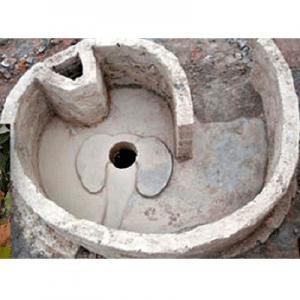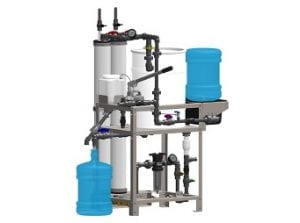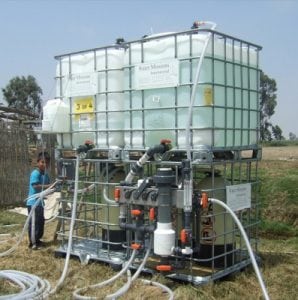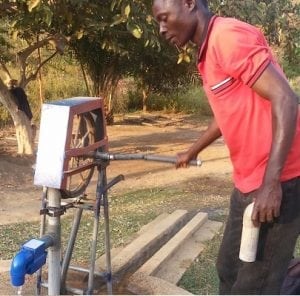
Agriculture
August 13, 2024
Elephant Toilet
Read SolutionImplemented by
The Africa Trust

Updated on January 12, 2024
·Created on August 25, 2020
An Arborloo is an ecological sanitation toilet in which trees are planted on top of the full pit while the superstructure, ring beam and slab are moved from pit to pit in a continuous cycle.
The Arborloo is a shallow pit on which a tree can be planted after it is full, while the toilet superstructure, ring beam and slab are moved to a new pit in a continuous cycle (usually moved once every 6 to 12 months). The pit should be about 1 to 1.5 m deep and should not be lined as it would prevent the tree or plant from growing properly.
The tree or plant should not be directly planted in the raw excreta. It should be planted in the soil on top of the pit, allowing its roots to penetrate the pit contents as it grows.
Arborloo designs will vary between communities but the ecological sanitation principle remains the same. It can be applied in rural, peri-urban, and denser areas if space is available.
Target SDGs
SDG 6: Clean Water and Sanitation
Market Suggested Retail Price
$22.00
Target Users (Target Impact Group)
Household, Community
Distributors / Implementing Organizations
Implemented by various organisations including Catholic Relief Services in East Africa, Water, Agroforestry, Nutrition and Development Foundation (WAND) in the Philippines
Competitive Landscape
Regions
Africa
Countries
Philippines
Manufacturing/Building Method
The Arborloo is constructed in a series of stages involving a concrete slab, ring beam to protect the pit, and superstructure.
The superstructure is most often made from local materials and will vary between the location and level of investment the household is willing to make for the superstructure (e.g. woven reeds, sticks, bricks, cement). The household generally provides the labor to dig the shallow pit and build the Arborloo, which approximately takes 2-5 hours.
After the Arborloo is constructed, a layer of leaves, ash, or soil is placed in the pit prior to its use by the household. Once the pit is approximately two-thirds full, the pit is backfilled with a thick layer of soil and a tree is planted on the nutrient-rich pit.
The household digs another Arborloo pit once the first one is filled, and the concrete slab and superstructure are moved to the new pit. The superstructure, ring beam and slab are moved from pit to pit in a continuous cycle.
Intellectural Property Type
Open-source
User Provision Model
The Arborloo is an open-source design. It is commonly built by the end-users with local construction support where available.
Distributions to Date Status
Unknown
Toilet type
Pit latrine
Evacuation method
Dry; a tree or plant is planted on the full pit while the structure is moved to another pit in a continuous cycle
Storage conditions
Pit
Capacity (L)
~500-700 L Based on 0.8 m pit diameter and 1-1.5 m pit depth
Time until emptying
6-12 months
Design Specifications
The Arborloo design is comprised of three main parts:
Technical Support
Local technicians and NGOs who are experienced in ecological sanitation in the respective country.
Replacement Components
Replacements and repairs are carried out by the end-users with local construction support where available.
Lifecycle
6-12 months prior to planting and cycling Arborloo to a new pit.
Manufacturer Specified Performance Parameters
Specified performance targets generally referred to for the Arborloo are summarised below:
Vetted Performance Status
The Arborloo is mainly assessed for its applicability in rural environments in the context of promoting sanitation noting its varied designs as an open-source solution. This assessment has been undertaken by various organisations through field trials and case studies. Common conclusions include its recommendation as a preferred solution in rural environments because of its low costs, ease of construction and quick return on investments.
Safety
Covering the pit and planting a tree reduces risk of infection due to reduced human contact with faeces contained below a layer of leaves and topsoil for separation. Users do not come into contact with faecal material reducing risk of pathogen transmission.
Complementary Technical Systems
Complementary technical systems include roofing structure to protect end-user from weather, vent pipe with fitted fly screen and pedestal for end-user comfort. Soil and ash should also be readily available to be dispatched into the pit after each use to reduce fly and odour nuisance.
Academic Research and References
Dionna, F,. et al., 2015, Adoption and sustained use of the Arborloo in rural Ethiopia: a cross-sectional study. Journal of Water, Sanitation and Hygiene for Development 5(3): 412–425
Shewa, W., Geleta, B., 2010, Arborloo for household sanitation, Arba Minch, Ethiopia. Case study of sustainable sanitation projects
Morabito, P., 2014, Plastic Arborloo Bases for Haiti. Environmental Science
Simpson-Hebert, M., 2007, Low-cost Arborloo offers Ethiopians health and agriculture benefits. Waterlines 26(2): 12-14.
Morgan P., 2007, Toilets That Make Compost: Low-cost, sanitary toilets that produce valuable compost for crops in an African context, Stockholm Environment Institute – EcoSanRes Programme.
IRC, 2013, Faecal sludge reuse interventions: the Arborloo and Fossa Alterna.
Herbert, P., 2010, Rapid Assessment of CRS Experience with Arborloos in East Africa. Catholic Relief Services.
Compliance with regulations
Unknown
Evaluation methods
The Arborloo has been primarily evaluated on terms of cost, constructability and quick return on investments in various contexts. Additionally, the solution type is also examined on why and how these factors are associated with adoption and sustained usage.
Other Information

Agriculture
August 13, 2024
Implemented by
The Africa Trust

Agriculture
August 14, 2024
Implemented by
Envirosan

Agriculture
January 8, 2024
Implemented by
Healing Waters International

Agriculture
January 16, 2024
Implemented by
George Greene III, PE, PhD

Agriculture
January 3, 2024
Implemented by
Department of Civil and Environmental Engineering, University of Virginia

Agriculture
June 24, 2024
Implemented by
WellDone

Agriculture
December 7, 2023
Implemented by
Nazava

Agriculture
June 23, 2024
Implemented by
Hans Hendrikse and Pieter Hendrisikse (Q Drum)

Agriculture
December 29, 2023
Implemented by
Folia Water

Agriculture
December 27, 2023
Implemented by
Shurflo Water Pumps
Have thoughts on how we can improve?
Give Us Feedback